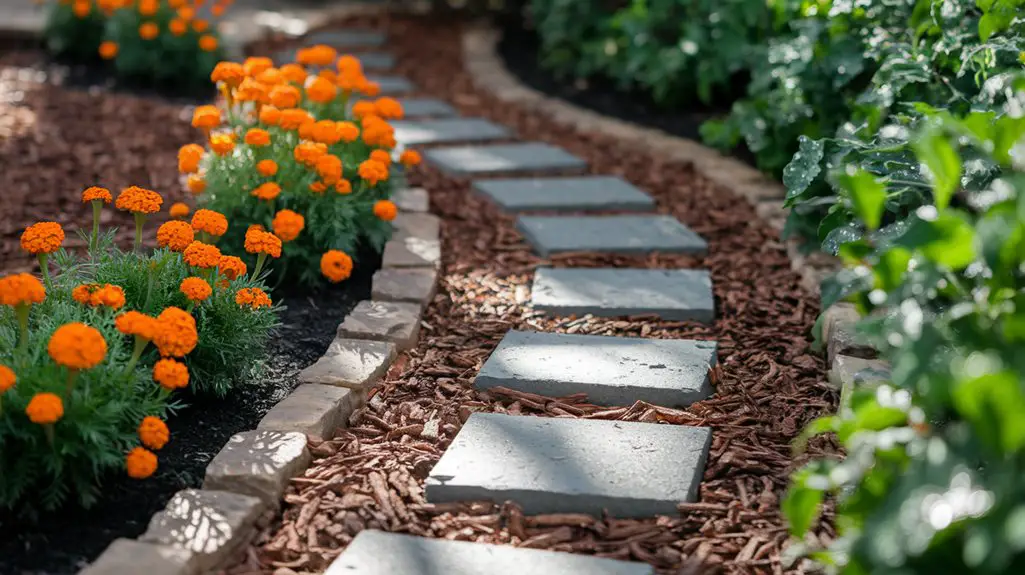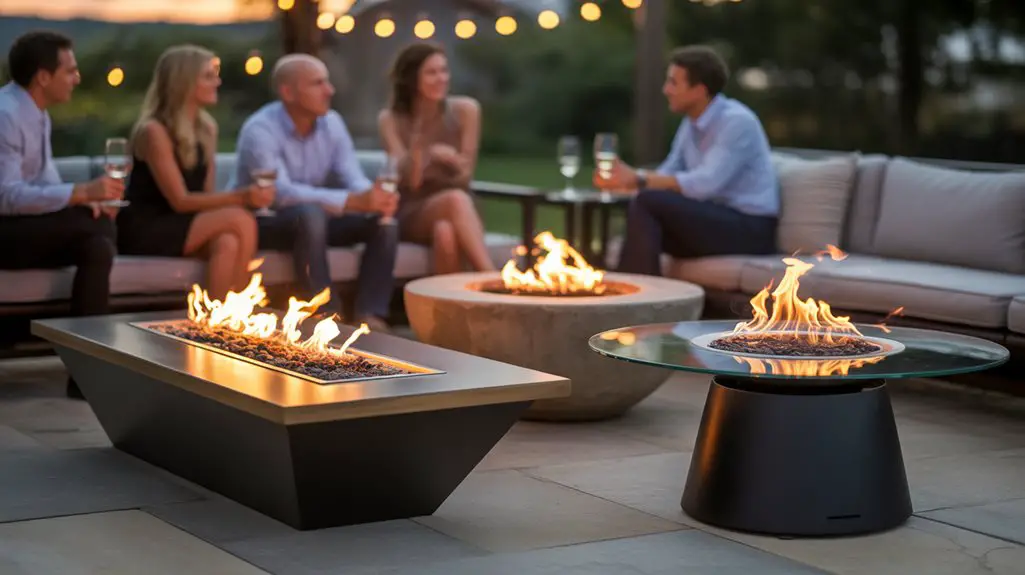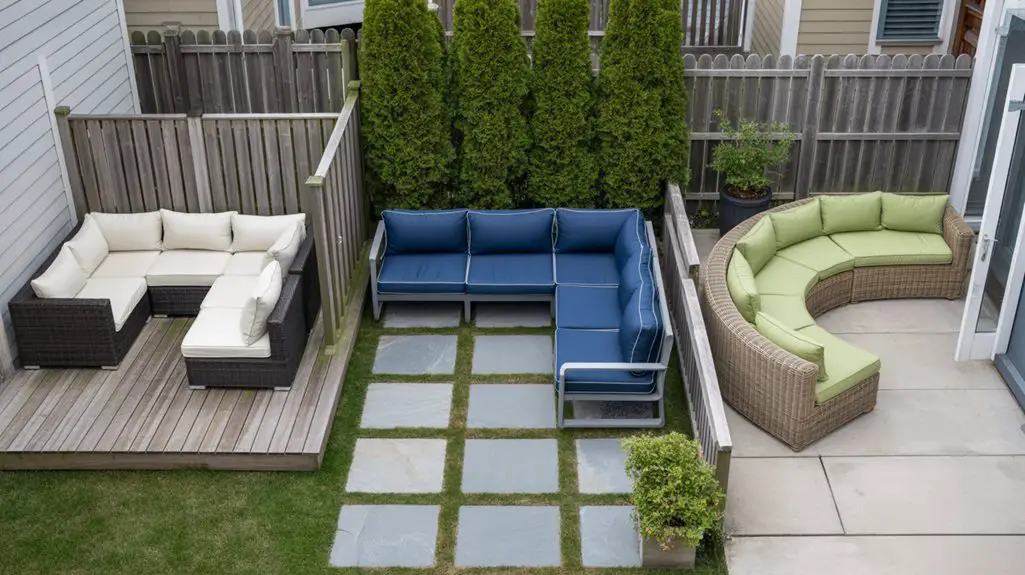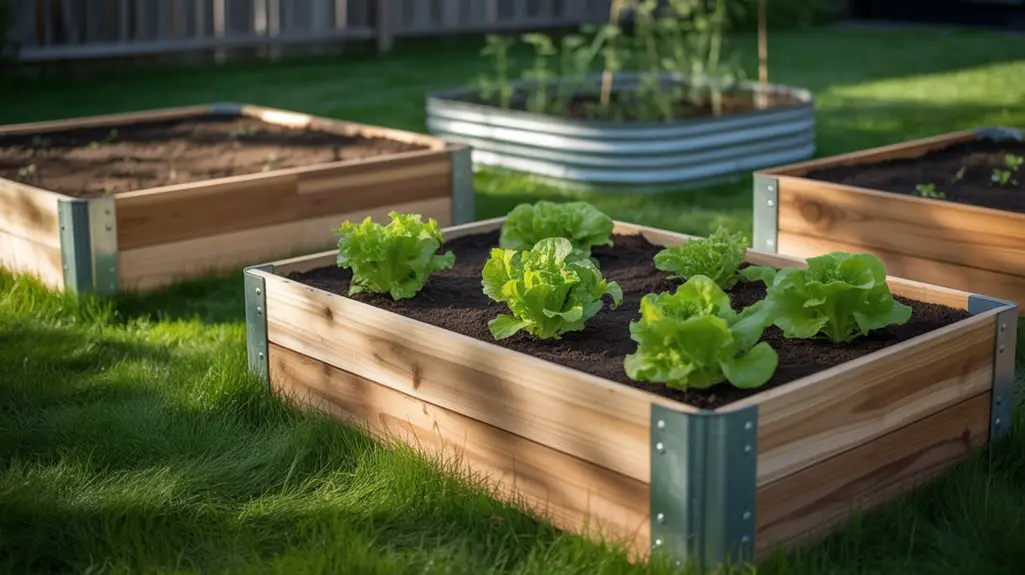Creating a beautiful garden pathway doesn’t have to break your budget. You’ll find multiple cost-effective materials that balance aesthetics with practicality while keeping expenses low. Gravel provides durability at under $2 per square foot, while wood chips offer natural appeal with even lower installation costs. For the truly budget-conscious, repurposed materials like salvaged bricks can create distinctive pathways for pennies on the dollar. But which option best suits your specific garden conditions?
Gravel and Crushed Stone: Budget-Friendly Path Basics
Among the most economical options for garden pathways, gravel and crushed stone offer exceptional value for homeowners on a budget. These materials typically cost $0.50-$2.00 per square foot, considerably less than concrete or pavers.
For ideal results, you’ll need 2-4 inches of depth, installed over landscape fabric to prevent weed growth. River rock (3/8″-3/4″), pea gravel (3/8″), and crushed granite (#10) provide different aesthetic and functional benefits. River rock drains well but shifts underfoot; crushed granite compacts for a firmer surface.
Installation requires minimal tools—just edging material, landscape fabric, a rake, and tamper. Additionally, stepping stones can be creatively integrated with gravel pathways to enhance visual appeal.
You’ll need to replenish these materials every 2-3 years and rake occasionally to maintain an even surface. For sloped areas, choose angular crushed stone that interlocks rather than rounded pebbles that migrate downhill.
Wood Chips and Mulch Pathways That Last

Wood chips and bark mulch represent another cost-effective pathway solution, typically ranging from $0.40-$1.25 per square foot when purchased in bulk.
These materials create soft, natural-looking pathways that complement informal garden designs while suppressing weeds and retaining moisture. To maximize longevity, install a quality landscape fabric beneath your mulch path, creating a 2-3 inch deep layer.
Cedar and cypress mulches resist decay better than pine varieties, extending your path’s useful life to 1-2 years before rejuvenation becomes necessary. Additionally, eco-friendly options like these contribute to a sustainable garden by enhancing soil health and reducing environmental impact.
Edge your mulch paths with pressure-treated lumber, stones, or metal edging to prevent materials from migrating into garden beds. For high-traffic areas, consider compacting the mulch slightly and reapplying a thin top layer seasonally to maintain proper depth and appearance.
Grass and Stepping Stone Combinations
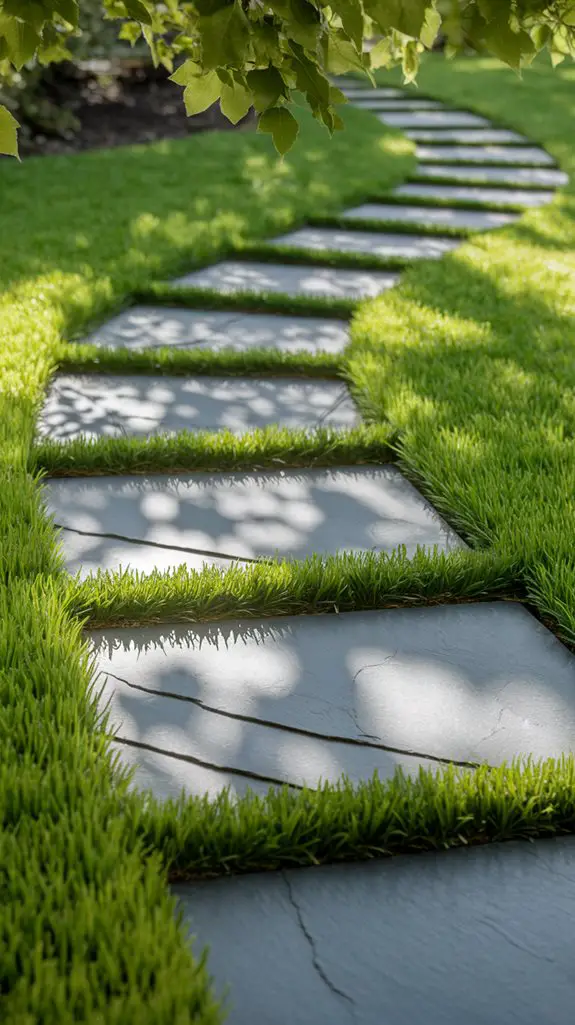
Combining stepping stones with grass creates an economical and visually appealing pathway solution that typically costs between $1.50-$5.00 per square foot, depending on your stone selection. This approach offers durability while maintaining a natural aesthetic in your garden space. Additionally, this design allows for budget-friendly backyard path ideas that enhance the overall charm of your landscape.
| Material Option | Cost/sq.ft | Longevity |
|---|---|---|
| Concrete pavers | $2.00-$5.00 | 25+ years |
| Flagstone | $3.00-$5.00 | 15-20 years |
| Recycled concrete | $1.50-$2.50 | 20+ years |
You’ll need to place stones 2-3 inches above soil level to facilitate mowing. Space pavers 12-24 inches apart for comfortable walking pace. Select drought-resistant grass varieties like fescue or Bermuda between stones to minimize maintenance. This combination works particularly well in moderate-traffic areas where you want to maintain some lawn while creating defined walking areas.
Repurposed Brick and Salvaged Materials
Repurposed brick pathways offer exceptional value with costs ranging from $0.50-$3.00 per square foot when using salvaged materials.
You’ll find these at demolition sites, salvage yards, and online marketplaces at fraction of retail prices.
For installation, prepare a 2-inch sand base, then lay bricks in herringbone, basket weave, or running bond patterns.
Fill joints with polymeric sand to prevent weed growth and stabilize the surface.
Beyond bricks, consider other salvaged options: broken concrete (“urbanite”), old slate roofing tiles, or ceramic tile remnants.
These materials provide unique textural elements while diverting waste from landfills. Additionally, using low-impact materials in your project can significantly enhance your backyard’s sustainability.
To extend material quantities, combine salvaged items with inexpensive fillers like pea gravel or decomposed granite.
This hybrid approach creates visually interesting paths while maximizing your budget.
Pine Needle and Natural Ground Cover Paths
Pine needle mulch ranks among the most affordable natural pathway materials at just $0.10-$0.30 per square foot when collected yourself. This acidic mulch works especially well around acid-loving plants like rhododendrons and blueberries. You’ll need to refresh this pathway annually as the needles decompose.
Other cost-effective ground covers include:
- Cedar chips ($0.50-$1.00/sq.ft): Naturally insect-resistant, lasting 3-5 years
- Shredded leaves (free): Collect in fall, shred with mower, apply 2-3″ thick
- Clover ($0.15-$0.25/sq.ft): Living pathway that tolerates light foot traffic
- Creeping thyme ($0.40-$0.80/sq.ft): Drought-tolerant option releasing pleasant aroma when stepped on
For all natural path materials, install landscape fabric underneath to suppress weeds and extend the pathway’s functional lifespan. Additionally, using low-maintenance materials can further simplify the upkeep of your garden walkway.
DIY Concrete Pavers on a Budget
While natural materials offer organic appeal, concrete pavers deliver exceptional durability at minimal cost when you make them yourself.
You’ll need only basic supplies: cement mix, sand, water, and molds. Repurpose plastic containers, baking pans, or commercially available mold forms to create custom shapes and sizes for your garden pathway.
- Mix 3 parts sand to 1 part cement, adding water until the consistency resembles thick oatmeal.
- Pour mixture into molds and tap sides to release air bubbles.
- Allow 24-48 hours curing time before removing from molds.
- Create interest by embedding glass pieces, stones, or pressed leaves.
- Apply concrete sealer to extend lifespan and enhance color.
Space pavers according to your walking stride, setting them on a 2-inch sand base for proper drainage and stability. Additionally, using modern outdoor seating designs can complement your garden pathway and enhance the overall aesthetic of your outdoor space.
Sand and Decomposed Granite Options
For those seeking highly economical pathway solutions, sand and decomposed granite stand out as two of the most affordable options available to home gardeners.
Coarse sand costs $30-50 per ton and provides excellent drainage, though you’ll need edging to keep it contained.
Decomposed granite (DG) offers more stability at $40-60 per ton. It’s available in various colors and compacts well when moistened and tamped. For best results, install a 2-3 inch layer over landscape fabric to prevent weed growth.
Both materials require periodic maintenance—sand needs occasional replenishment, while DG might need recompacting after heavy rains.
Consider your climate before choosing; sand works well in drier regions, while stabilized DG performs better in areas with significant rainfall.
Creative Upcycled Materials for Unique Garden Walkways
Resourceful gardeners can transform everyday discarded items into distinctive pathway materials at minimal cost. These repurposed elements add character to your landscape while diverting waste from landfills. You’ll find many upcycled options require minimal preparation before installation.
- Broken concrete slabs (“urbanite”) can be arranged in mosaic patterns with gaps for groundcover.
- Salvaged brick from demolition sites creates classic pathways when laid in herringbone or basket weave patterns.
- Wine bottle bottoms set in concrete form colorful stepping discs that catch sunlight.
- Fallen tree slices cut into rounds provide natural wood stepping stones when sealed properly.
- Reclaimed wooden pallets disassembled into planks create boardwalk-style paths when treated with preservative.
Consider your climate conditions when selecting materials, as some upcycled options may deteriorate faster in wet environments. Additionally, incorporating rustic pathway options can enhance the overall aesthetic of your garden space.
Conclusion
Your pathway doesn’t need to drain your wallet. By selecting materials like gravel ($0.50-$2.00/sq.ft), wood chips ($0.40-$1.25/sq.ft), or repurposed items (under $0.30/sq.ft), you’ll create functional garden routes that serve as ribbons connecting your landscape’s features. Each option offers distinct technical advantages—drainage properties, compression resistance, or biodegradability. Analyze your soil conditions, traffic patterns, and aesthetic requirements to determine which budget-friendly material best suits your specific application.

